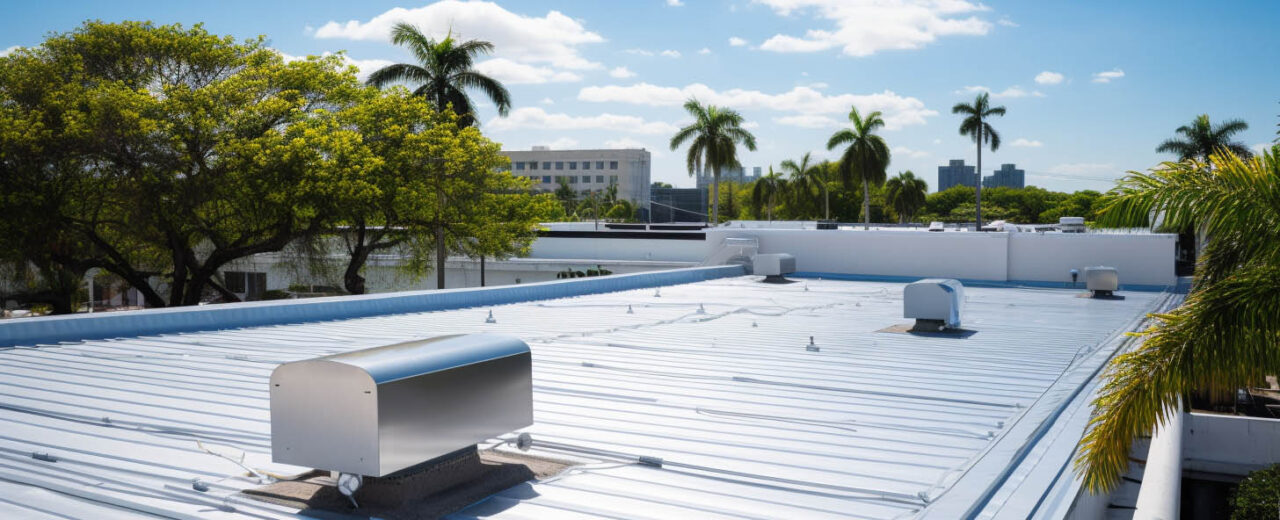What is a Cool Roof?
A cool roof is designed to absorb and transfer less heat from the sun to the building than a conventional roof. The primary characteristic of a cool roof is its high solar reflectance, also known as albedo. This feature enables a cool roof to efficiently reflect heat from the sun away from a structure. Additionally, a cool roof’s high thermal emittance plays a crucial role, especially in warm and sunny climates, by effectively shedding the heat it does absorb.
The benefits of cool roofs are manifold. Not only do they reduce temperatures on the roof and inside the building, but they also contribute to a more comfortable indoor environment. For instance, in non-air-conditioned residential structures, cool roofs can decrease peak indoor temperatures by 1.2–3.3°C (2.2 to 5.9°F). Moreover, they play a pivotal role in mitigating the heat island effect, a phenomenon where urban areas experience higher temperatures than their rural surroundings.
How Cool Roofs Benefit the Environment and Communities
Energy Conservation
One of the primary advantages of cool roofs is the reduction in energy consumption. By minimizing the heat transferred to a building, cool roofs enable structures to remain cooler, reducing the need for air conditioning. In air-conditioned residential buildings, the solar reflectance from a cool roof can diminish peak cooling demand by 11–27%.
Environmental Impact
Cool roofs contribute to a decrease in air pollution and greenhouse gas emissions. By reducing energy consumption, they indirectly lead to a reduction in the associated environmental pollutants. On a larger scale, when cool roofs are widely adopted, they can potentially reduce the formation of ground-level ozone and decrease cooling energy consumption across an entire city.
Health and Comfort
Heat islands can have detrimental health effects, including heat exhaustion, respiratory issues, and even heat-induced fatalities. Cool roofs can significantly mitigate these adverse health impacts. A study in the United Kingdom demonstrated that when cool roofs are implemented city-wide, they can counteract 18% of heat-related deaths associated with the heat island effect.
Equity Considerations
Scientific evidence indicates that low-income individuals and communities of color are disproportionately affected by heat islands. By reducing the heat island effect in these neighborhoods, cool roofs can alleviate the health risks and energy cost burdens faced by these communities.
Cool Roofing Solutions by The Roofing Center
At The Roofing Center, we understand the significance of cool roofs in today’s changing climate. As a leading roofing service in Fort Collins CO, we offer a range of cool roofing solutions tailored to both residential and commercial needs. Our team of Fort Collins roofing contractors is trained to install cool roofs that not only enhance the energy efficiency of your building but also contribute to a sustainable future.
Whether you’re looking for a roof repair in Fort Collins or considering a complete roof overhaul, The Roofing Center is committed to delivering top-notch services that align with the latest environmental standards.
Cool Roof Programs and Incentives
To promote the adoption of cool roofs, various building standards, codes, ordinances, and financial incentives have been introduced at local, state, federal, and international levels. These programs are often integrated into broader initiatives related to energy efficiency, green buildings, and climate change mitigation. They are typically managed by utilities, state and local governments, and non-profit organizations.
For instance, cool roof requirements have been incorporated into building and energy standards in numerous cities, states, and regions. Additionally, financial incentives, such as rebates and loans, are available in various states to support the installation and maintenance of cool roofs.
Conclusion
Cool roofs are more than just a roofing solution; they are a step towards a sustainable and energy-efficient future. By reflecting solar heat and reducing the heat island effect, cool roofs play a pivotal role in conserving energy, reducing environmental pollutants, and enhancing the health and comfort of communities. As we move towards a future marked by climate change, the adoption of cool roofs will be crucial in creating resilient and sustainable urban environments.
>


